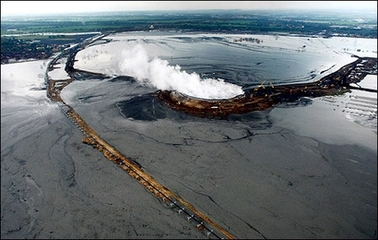Despite the sarcasm, I have been following the attempt to stem the flow of mud from Lusi with some interest, if only because the whole thing sounds like its been dreamed up by the Star Trek technobabble generator (not to mention the guilty schoolboy pleasure of seeing so many headlines containing the phrase ‘concrete balls’). However, reports on exactly what the situation was last week seemed heavily dependent on whom you talked to. For example, the two guys in this report didn’t seem to be on the same page:
“We are still evaluating. We are studying the volume of the flow, which has now increased from 125,000 cubic metres to 160,000 cubic metres a day,” said Rudi Novrianto, a spokesman for the government team tasked with dealing with what scientists dub the “mud volcano”.
He said pebbles, sand and stones the size of tennis balls had now been found in the mud, in addition to clay.
But Satria Bijaksana, a member of a separate team of scientists who initiated the concrete ball experiment, said mud pressure had eased after the balls were dropped.
“We have noticed an increase in hydrogen sulphide, indicating that pressure is decreasing,” Bijaksana told Reuters.
It’s certainly quite novel to see the government being more pessimistic about a disaster than the scientists. I suppose the two could in fact be consistent – movement of the chains at depth could have been eroding the edges of the vent, explaining the debris in the outflow, and the widening bore could have led to increased outflow at reduced pressures.
At the end of last week, there was a bit more agreement: another member of the science team told Reuters that “the flow had decreased by about 20 percent”, although the “observation is relative, not absolute,” The government decided to be more precise, claiming outflow had fallen to 80-90,000 cubic metres a day. My original post cited highly variable rates of eruption, from 7,000-150,000 cubic metres a day; such variability makes it quite hard to quickly spot a systematic trend, which perhaps made the announcement that 500 more chains were going to be dropped into the vent a little premature, especially in the light of the most recent news:
Mudflow in Sidoarjo regency, East Java stopped for 35 minutes Monday as engineers had dropped thousands of concrete balls into the mouth of mud volcano.
Haryo Bagus Handoko, an engineer who lead the concrete ball droppings, said Monday that it was a good indication over the effort to stop the mud flow, which have taken place since May last year.
This assumes, of course, that such lulls were not occurring before they started dropping things down the vent. Still, the Indonesian scientists may yet get to spit in the eyes of the sceptics.




Comments (8)